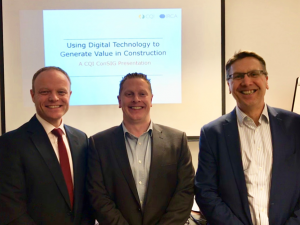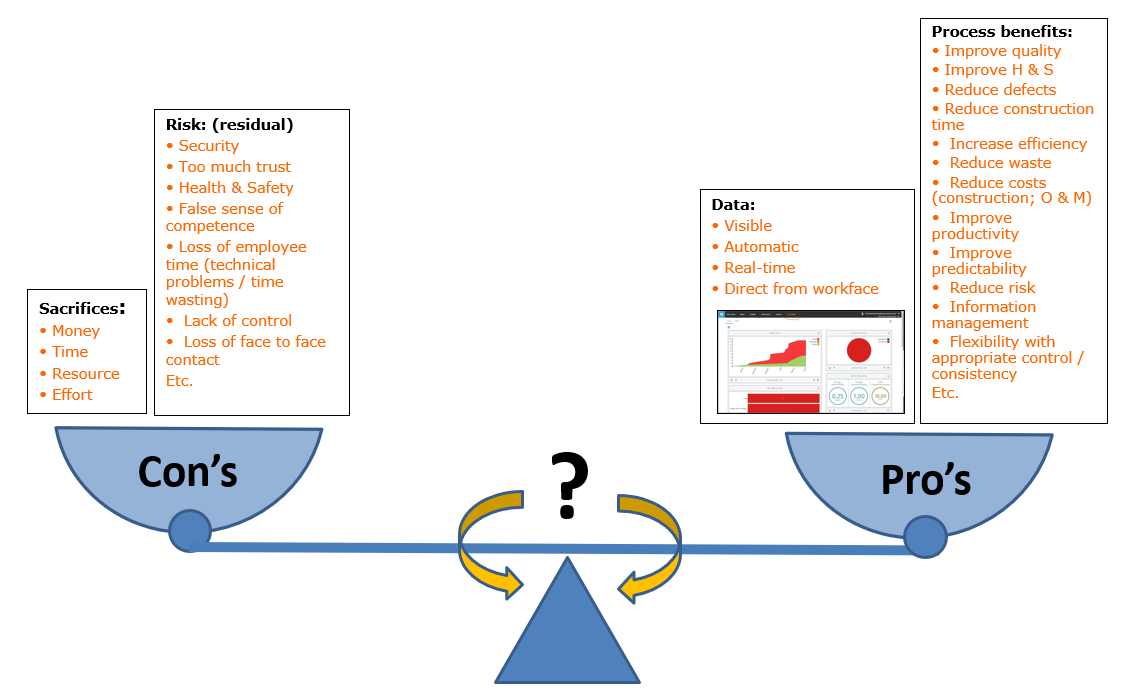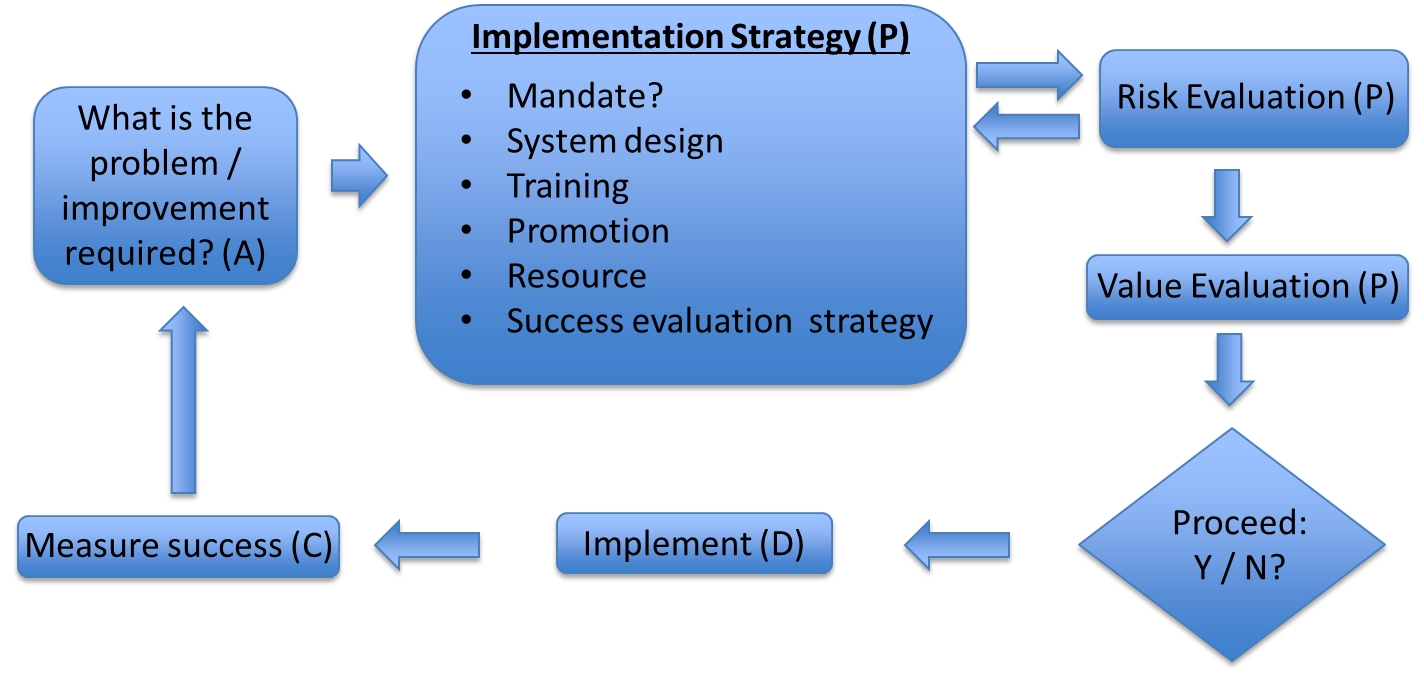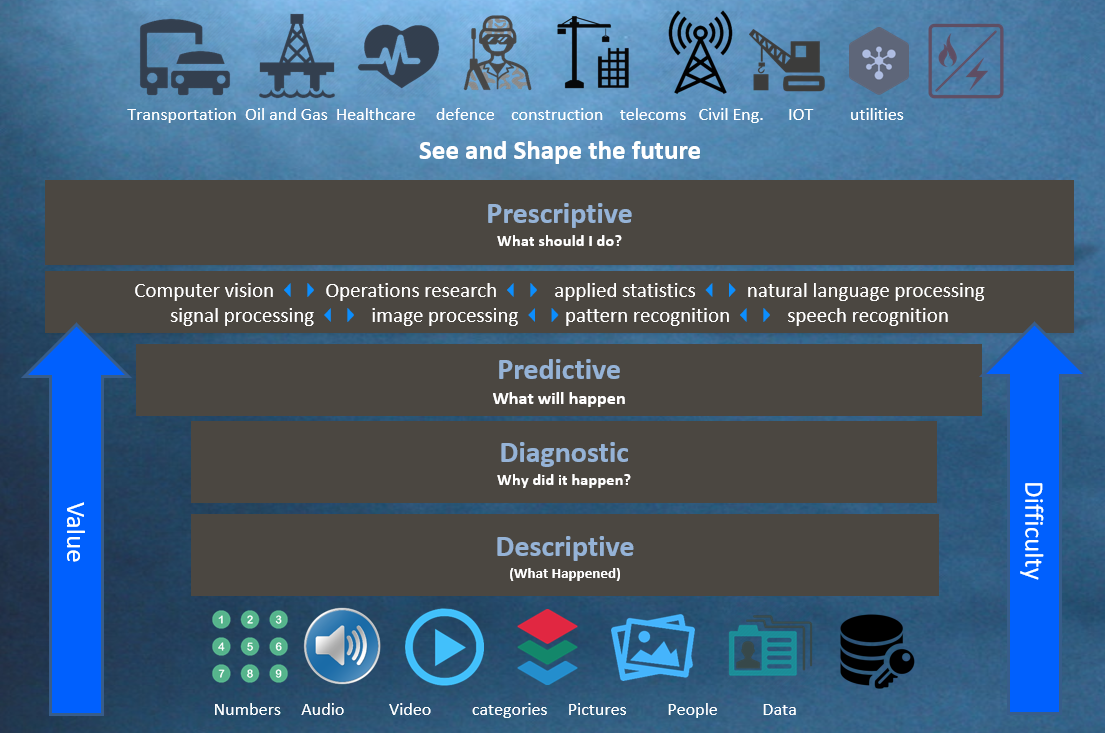(A pdf copy of the presentation slides can be downloaded here.)
The Construction Special Interest Group (ConSIG) extends its thanks to all those who attended the event ‘Using Digital Technology to Generate Value in Construction’ on Wednesday 7th March, 2018. The event was a great success and feedback extremely positive:
“A very interesting event with a lot of good information shared”; “really thought provoking“; “the info is useful and of direct interest to our industry“

Presenters: (left to right) Rob Youster, Mike Buss & Ian Mills
The event aimed to give those attending an insight into the personal experiences and lessons learned by those involved in implementing digital field tools to help achieve maximum value.
Implementing Tablet Technology on Projects: Mike Buss (Head of Quality, Taylor Woodrow)
Mike Buss, Head of Quality Taylor Woodrow, provided a synopsis of his experience implementing field technology. Although this started out with PDA’s and progressed to tablets, Mike suggested that these devices be viewed as enablers for field technology with the future perhaps bringing new improved possibilities. Mike then demonstrated how, although some initiatives had been extremely successful, others had not. This sparked Mike’s interest in understanding why this is the case and Mike undertook an academic study as part of an MSc to explore the reasons. Mike provided an overview of the research findings explaining how tablet technology can provide value looking at ‘how’ from the perspective of both the benefits and the methodology.
It is virtually impossible to list all the benefits of field technology. Its ability to combine aspects from many technologies and continuously add functionality through, for example, software applications creates endless possibilities. Field technology may also bring about innovation in ways perhaps not even yet conceptualised. Mike proposed that the benefits from field technology be classified in two ways. Firstly, field technology can facilitate improvement to any process, at any stage of the construction and for all parties resulting in many potential benefits such as increased productivity, improved quality and reduced risk. Secondly, field technology provides real-time and automated data directly from the workface offering much clearer visibility of performance.
Conversely, though, there are cons. The finance, human resource and effort required to implement must be considered. Furthermore, it can introduce additional risks. Security concerns (e.g. data theft) is the most well-known but there are others such as distraction causing health and safety issues. These risks must be adequately mitigated.
The ‘Value’ generated by field technology implementation may be considered a ‘weigh up’ of these benefits and cons (Figure 1).

Figure 1: ‘Weigh up’ of pro’s and con’s from field technology
The perception of the pros and cons may be different at corporate, project and user levels. For example, users will likely be less concerned with cost and more focussed on the effort required to learn and use the technology. For project managers, cost may be a key consideration.
Mike explained that the aim of any technological implementation scheme should be for the technology to be ‘adopted’ (i.e. used regularly in practice). Although this may be achieved through mandating its use, it is preferable that the technology is ‘accepted’ (looked upon favourably) by users. By adequate consideration of these aspects, a strategic approach can be initiated to bring about effective implementation and generate maximum return on investment. Field technology should be introduced through a PDCA approach based on a specific problem or when an improvement opportunity is identified. Planning should involve creating a robust implementation strategy which includes system design, resource allocation and adequate training. Corresponding risks can then be identified and mitigated and a more accurate value assessment completed. The technology can then be implemented, success evaluated, and any identified improvements made.

Figure 2: Proposed strategic technology implementation approach
Using Tablet Technology as an Enabler: Ian Mills (Head of Quality, Balfour Beatty)
Ian Mills, Head of Quality Balfour Beatty, further elaborated on implementation of field technology. Ian provided a recollection of his own experiences and the challenges encountered over a ten year period obtaining buy in from senior executives. Ian’s tenacious approach eventually paid off resulting in a charter whereby the technology would be adopted on 50 projects. Success factors were established and through feedback and productivity assessment, the initiative was proved to be a resounding success. This included a ‘day in the life of an engineer’ which identified a 25% productivity saving for site engineers. This catalysed growth of the initiative within the Building division and field technology is now mandated by the Managing Director, used by over 200 projects, and has over 2000 users. Subsequent benefits include better delivery and less variable projects. However, one of the key benefits is the data. Metrics related to planning delivery and issue management can be analysed more easily. This has resulted in quality being discussed at board level and now even senior managers discuss Inspection & Test Plans. Ian showed examples of how real-time data is providing visibility of process performance (Figure 3).

Figure 3: Example of real-time data providing visibility of process performance
In particular, this demonstrates how projects are currently managing issues as 97% reactive and only 3% proactive.
However, aligned with many of the aspects discussed by Mike, Ian recounted challenges faced during the implementation. In addition to gaining user buy-in and data security, this included client concerns over data residency, gaining supplier involvement and accommodating different systems.
Ian confirmed that field technology will be a key initiative for the company going forward and will be expanded into other areas of the business and continually developed and enhanced to bring further improvements. Not only is this planned to help with progressive assurance but also use data as a key tool to fix the root cause of issues.
Ian reflected on his belief that tablet technology will be a “step change in the construction sector” and “once started the isn’t any going back”.
Understanding the value of smart data: Rob Youster (Head of ICT at BAM Nuttall)
Rob Youster, Head of ICT BAM Nuttall Limited, provide a vivid and thought-provoking overview of how data intelligence is the future.
Rob firstly reflected on how far technology has developed since the 1980’s with, for example, 1 billion people now owing an iPhone and over 50 billion devices expected to be connected by 2020. Rob then explained ‘The Big 3’—Big Data, Data Science, and Data Analytics. One of the key challenges today is that there is so much data, that greatest value will be achieved when data is used to make intelligent decisions. Big data refers to the large data sets available whereas data analytics refers to the techniques which can be used to” identify and analyse behavioural data and patterns”. Smart data will move us from using data to understand what happened (‘descriptive’) to why it happened (‘diagnostic’) and then onwards to what will happen (‘predictive’) and ultimately informing what should be done (‘prescriptive’). This aims to provide the ability to “see and shape the future”.

Figure 4: Using data to predict what we should do
Rob provided examples of where this is being applied in real life including construction—building digitally first (i.e BIM) provides the opportunity to connect data ‘smartly’.
Rob, lastly challenged everyone to think about just how connected everyone really is—more than we may be aware—using a hypothetical example of someone from waking up 30 minutes late to arriving at work and the possible influence of technology available today.
Conclusion
These three interrelated presentations highlighted how field technology has the potential to radically transform delivery in construction. Not only is this due to the many benefits which the technology has and can bring in future but also the capability to provide real-time and visible data. This will inform but also help resolve issues. Furthermore, when used intelligently, this data may provide the ability not only to explain why but prescribe what should be done in the future.
Effective field technology implementation though, has not been without its challenges and leadership must make appropriate decisions to ensure it can be successfully adopted to generate the value required throughout organisations and across the construction industry. Strategic Implementation is key.
